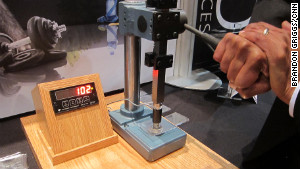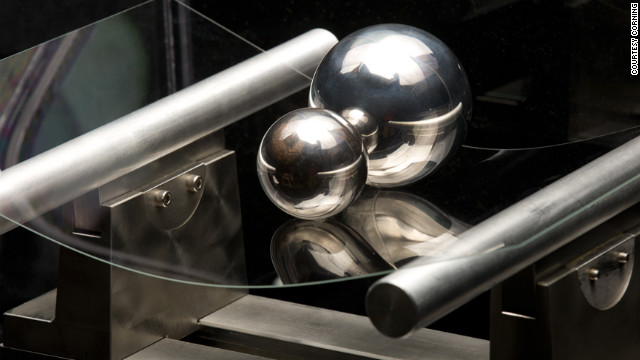The new Corning glass supports two steel balls, showing its strength and flexibility.
When it comes to innovation in electronic gadgets, a new kind of glass is not especially sexy.
But when that glass is built into millions of touchscreen devices, and could potentially make them thinner, lighter and more responsive to your finger, consumers may take notice.
Corning Inc. says Gorilla Glass 2 is thinner and more touch-sensitive without sacrificing toughness or resistance to scratches. The company showed off the glass Monday at a gadget-showcase event at the International Consumer Electronics Show here and is showing live demos of its enhanced qualities at the Corning booth throughout the four-day show.
The new glass is not any less resistant to breakage than the current Gorilla Glass, which may be disappointing news to anyone who has had to put up with a cracked screen after dropping a phone.
"It's not scratch-proof. And if they drop it on granite, it can be broken," said Corning general manager Clifford Hund. But he added that Corning has managed to make the glass 20% thinner but just as strong -- a key advancement at a time when smartphone and tablet makers are trying to produce ever-thinner devices.
The second generation of Gorilla Glass will debut in Windows-based PCs this year. Other manufacturers also are weighing how and when to add the glass to their upcoming devices, Hund said.

More than 100 pounds of pressure are exerted onto the glass in this demonstration, but it doesn't break.
The glass also has been engineered to let more light through, creating a brighter display screen, Corning executives said.
Due to customer nondisclosure agreements, Corning cannot name all the devices that use Gorilla Glass -- including Apple products. But according to multiple other sources, including Walter Isaacson's recent biography of Apple co-founder Steve Jobs, the product's first consumer application was the original iPhone in 2007.
A passage from Isaacson's book details how Apple had originally planned to use plastic display coverings for its iPhone before Jobs approached Corning CEO Wendell Weeks about ordering glass instead. Weeks told him Corning had developed a tough form of glass, made extra strong by a chemical process, but couldn't find a market for it.
Weeks didn't think Corning could manufacture the glass fast enough to meet Apple's timetable for the iPhone launch. But at the prodding of Jobs, who wouldn't take no for an answer, Corning did it in six months.
After the iPhone hit the market, Jobs sent Weeks a note that said, "We couldn't have done it without you."
Gorilla Glass also is part of touchscreens in electronic devices by Acer, Asus, Dell, HTC, LG, Motorola, Nokia, Samsung and Sony, among other manufacturers.
Amin demonstrated its toughness Monday by placing a small square of the original glass in a lever press, then applying more than 100 pounds of pressure onto it. Despite looking like he was truly exerting himself, he couldn't break it. Amin then tested the new glass the same way and got the same result.

